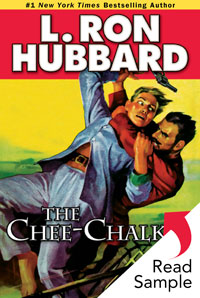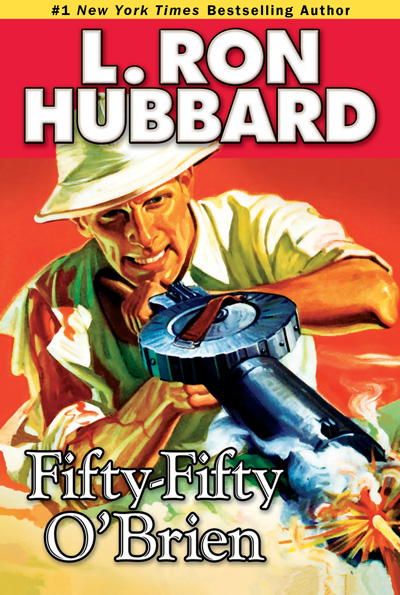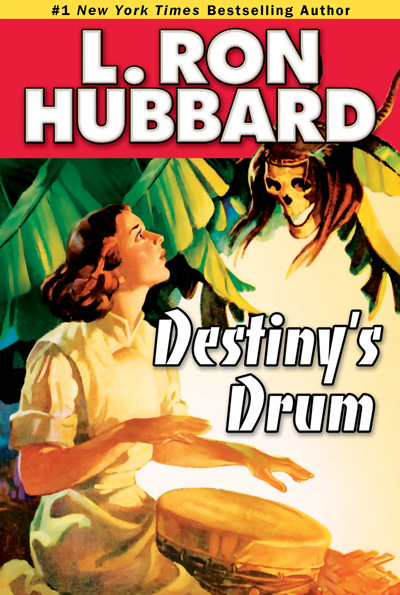Chee-Chalker: a newcomer to Alaska and the Klondike; an Indian word meaning one who is inexperienced or has no knowledge; a tenderfoot.
Bill Norton might be new to Ketchikan but he’s no tenderfoot. In fact, he’s one of the sharpest FBI agents this side of the Yukon—savvy, tough and resourceful.
Norton’s come to this rough-and-tumble town to look into a case of a missing person—his own boss—who vanished investigating a heroin smuggling operation. What Norton finds is a string of corpses, a gallery of rogues, and a fleet of fishing boats that specialize in red herrings. He also finds himself warming up to the heart-stopping halibut heiress Elaine Halloway.
But is Elaine mixed up in the heroin trade … or a victim of it? To find the truth Norton will have to make living men sweat—and dead men talk. Because every body fished out of the icy waters has a story to tell, and it will take all of Norton’s CSI-like skills to squeeze it out of them.
SAMPLE

ABOUT THE AUTHOR
L. Ron Hubbard wrote The Chee-Chalker in 1940 while on his Alaskan Experimental Radio Expedition. One of its main purposes was to test an experimental radio navigation system enabling the user to locate the source of radio transmissions. While in Ketchikan, Ron used this equipment to assist the US Army Signal Corp, Coast Guard, and local FBI. In the process, he helped uncover a Nazi saboteur who had invented a device to interfere with radio transmissions between Alaska and the continental United States. So it’s not surprising that a radio station plays a significant role in this story.
The Chee-Chalker Glossary
Stories from the Golden Age reflect the words and expressions used in the 1930s and 1940s, adding unique flavor and authenticity to the tales. While a character’s speech may often reflect regional origins, it also can convey attitudes common in the day. So that readers can better grasp such cultural and historical terms, uncommon words or expressions of the era, the following glossary has been provided.
blackjack: a short, leather-covered club, consisting of a heavy head on a flexible handle, used as a weapon.
button, on the: a blow on the tip of the chin; jawbreaker; a hard blow that usually causes a knockout.
carbine: a short light rifle.
chee-chalker: a newcomer to Alaska and the Klondike; an Indian word meaning one who is inexperienced or has no knowledge; a tenderfoot.
Colt Frontiersman: Colt Frontier Six-Shooter; a .44-caliber, single-action revolver made by the Colt Firearms Company, established in 1847 by Samuel Colt (1814–1862). The Colt Frontier was originally made to be compatible with .44-caliber “Winchester Central Fire” cartridges, a cartridge that was commonly used in Winchester rifles.
Colt revolver: Colt Detective Special; a short-barreled revolver first produced in 1927 by the Colt Firearms Company. Though originally offered as a .32 caliber, the most common of the Colt Detective Specials were .38 caliber and had a two-inch barrel. The short barrel design made this gun popular for use as a concealed weapon by plainclothes police detectives.
eyes of the ship: the forwardmost portion of the topmost deck of a ship, as far forward as a person can stand. The name comes from the ancient Chinese custom of painting eyes on each bow so that the ship could see where she was going.
Fates: the Fates, in classical mythology, are the three goddesses Clotho, Lachesis and Atropos, who control human destiny.
fo’c’s’le head: forecastle head; the part of the upper deck of a ship at the front. The forecastle is the front of a ship, from the name of the raised castlelike deck on some early sailing vessels, built to overlook and control the enemy’s deck.
forepeak: the interior part of a boat or ship nearest the bow.
forty-five or .45: a handgun chambered to fire a .45-caliber cartridge.
fulminate of mercury: a gray crystalline powder that when dry explodes under percussion or heat and is used in detonators and as a high explosive.
fusel oil: an acrid oily liquid occurring in insufficiently distilled alcoholic liquors. Used especially as a source of alcohols and as a solvent.
gangway: a narrow, movable platform or ramp forming a bridge by which to board or leave a ship.
gibbet: an upright post with a crosspiece, forming a T-shaped structure from which criminals were formerly hanged for public viewing.
G-men: government men; agents of the Federal Bureau of Investigation.
gunwale: the upper edge of the side of a boat. Originally a gunwale was a platform where guns were mounted, and was designed to accommodate the additional stresses imposed by the artillery being used.
gurdy: a reel with a crank used to pull in fishing nets on a boat.
hard by: in close proximity to; near.
hawser: a thick rope or cable for mooring or towing a ship.
Juneau: port city in southeastern Alaska. In 1900 it was made the capital of the territory of Alaska and later the state capital when Alaska joined the Union in 1959. It is named after the gold prospector Joseph Juneau, who discovered gold in the area in 1880.
kapok: a silky fiber obtained from the fruit of the silk-cotton tree and used for insulation and as padding in pillows, mattresses and life preservers.
Ketchikan: a city located on the southwestern coast of Revillagigedo Island near the southern boundary of Alaska, and named after the Ketchikan Creek that flows through the town. Much of the town sits over water, supported by pilings. Ketchikan has the heaviest average rainfall in North America and is one of the four wettest spots on Earth. With 160 inches of rain a year, the rainfall is measured in feet, not inches. The locals refer to rain as “liquid sunshine.”
klootches: Indian women of northwestern Alaska.
Marquis of Queensberry: referring to the official rules for the sport of boxing; originated by John Sholto Douglas (1844–1900), a British nobleman and eighth Marquis of Queensberry (a hill in lower Scotland).
Mascot: Mascot Stove Company; company that made coal stoves.
Mickey: Mickey Finn; a drug-laced drink given to someone without their knowledge in order to incapacitate them. Named after a bartender who, before his days as a saloon proprietor, was known as a pickpocket and thief who often preyed on drunken bar patrons.
MP: Military Police.
muskeg: a swamp or bog formed by an accumulation of moss, leaves and decayed matter resembling peat.
newshawk: a newspaper reporter, especially one who is energetic and aggressive.
physiognomy: the features of somebody’s face, especially when they are used as indicators of that person’s character or temperament.
rotgut: raw, inferior liquor.
sap: blackjack; a short, leather-covered club, consisting of a heavy head on a flexible handle, used as a weapon.
Scheherazade: the female narrator of The Arabian Nights, who during one thousand and one adventurous nights saved her life by entertaining her husband, the king, with stories.
scow: an old or clumsy boat; hulk; tub.
seine boat: fishing boat; a boat specially constructed to carry and utilize a seine, a large net. One edge of the net is provided with sinkers and the other with floats. It hangs vertically in the water and when its ends are brought together or drawn ashore it encloses the fish.
Sitka: a port city in the southern part of Alaska, on the Pacific Ocean.
Siwash: a North American Indian of the Pacific Northwest, Northwest Canada and Alaska.
“snow”: cocaine or heroin in the form of a white powder.
sou’wester: a waterproof hat with a wide brim that widens in the back to protect the neck in stormy weather, worn especially by seamen.
SS: steamship.
stern: the rear end of a ship or boat.
thirty-eight: thirty-eighth parallel north; an imaginary circle of latitude that is thirty-eight degrees north of the Earth’s equator. The thirty-eighth parallel north runs through the United States of America.
thirty-thirty or .30-30: Winchester model 1894 rifle that is chambered to fire a .30-30 cartridge, the first North American sporting cartridge designed for use with smokeless powder. The .30-30 is a .30-caliber cartridge that was originally loaded with 30 grains of the new smokeless powder, which is the source of its name.
Thomas Basin: a boat harbor in Ketchikan, Alaska.
Tlingits: a Native American people inhabiting the coastal and island areas of southeast Alaska.
Tongass Narrows: the channel of water that runs between Ketchikan and Gravina Island, located in the southern part of Alaska. Tongass Narrows is Ketchikan’s “main street” and is used by cruise ships, commercial tugs, fishing boats and floatplanes.
transom: transom seat; a kind of bench seat, usually with a locker or drawers underneath.
twenty-five or .25: a small handgun chambered for the .25 ACP (Automatic Colt Pistol) cartridge designed by American firearms inventor John M. Browning (1855–1926).
Uncle Sam: the cartoon embodiment of the government of the United States of America beginning in the first part of the nineteenth century. The initials US, of Uncle Sam, were also taken to stand for “United States.”
well deck: space on the main deck of a ship lying at a lower level between the bridge and either a raised forward deck or a raised deck at the stern that usually has cabins underneath.












